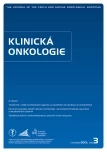Tobacco Dependence Treatment
Authors:
M. Šebestová; B. Jakubíčková; J. Skřičková
Authors‘ workplace:
Centrum pro léčbu závislosti na tabáku, Klinika nemocí plicních a tuberkulózy LF MU a FN Brno
Published in:
Klin Onkol 2013; 26(3): 219-220
Category:
Short Communication
Overview
Background:
Nicotine is a highly addictive drug with long-term effects on somatic and nervous systems of an individual. The tobacco dependence is a chronic disease which requires an intensive and complex treatment. The treatment should be focused on physical as well as psychological dependence. Nicotine dependence is a disease with a high relapse tendency, therefore requiring long-term therapy as well as patient’s determination and motivation.
Patients and Methods:
We have focused on evaluation of results of our tobacco dependence center over previous 3 years (2010, 2011, 2012). The treatment success is evaluated one year after the first visit at the center (therefore the results for 2012 are not yet available).
Results:
In 2010, 57 new patients visited our tobacco dependence center (34 men and 23 women); the average age of the patients was 42.3 years. The treatment was successful in 15 out of 57 patients (26.3%). In 2011, 40 new patients (23 men and 17 women) visited the center; the average age was 45 years. The treatment was successful in 13 out of 40 patients (32.5%). In 2012, 50 new patients visited the center, the average age of the patients was 44.4 years. As the success of the treatment is evaluated in yearly intervals, the results for 2012 are not yet available.
Conclusion:
Treatment of nicotine dependence is essential for the prevention of cardiovascular, pulmonary and oncological diseases. In previous 3 years, 147 new patients visited our tobacco dependence center. The average age of patients coming to the center in order to start treatment was 43.9 years, and their nicotine dependence was fully developed. In the future, we would like to focus on younger age groups, where in general the onset of the dependence is very frequent.
Key words:
tabacco use disorder – tabacco use cessation – prevention and control
Sources
1. Whqlibdoc.who.int [homepage on the Internet]. WHO Global Report: Mortality Attributable to Tobacco. c2011 [updated 2011 Dec; cited 2013 Feb 20]. Available from: http:/ / whqlibdoc.who.int.
2. ÚZIS ČR [internetová stránka]. Ústav zdravotnických informací a statistiky ČR. Evropské výběrové šetření o zdravotním stavu v ČR – EHIS CR (Kouření a vystavení tabákovému kouři). Česká republika; c2011 [aktualizováno 12. ledna 2011; citováno 20. února 2013]. Dostupné z: http:/ / www.uzis.cz.
3. Králiková E, Býma S, Cífková S et al. Doporučení pro léčbu závislosti na tabáku. Cas Lek Cesk 2005; 144(5): 327 – 333.
4. Leone FT, Evers ‑ Casey S. Behavioral intervention in tobacco dependence. Prim Care 2009; 36(3): 489–507.
Labels
Paediatric clinical oncology Surgery Clinical oncologyArticle was published in
Clinical Oncology

2013 Issue 3
- Metamizole at a Glance and in Practice – Effective Non-Opioid Analgesic for All Ages
- Possibilities of Using Metamizole in the Treatment of Acute Primary Headaches
- Metamizole in perioperative treatment in children under 14 years – results of a questionnaire survey from practice
- Safety and Tolerance of Metamizole in Postoperative Analgesia in Children
- Obstacle Called Vasospasm: Which Solution Is Most Effective in Microsurgery and How to Pharmacologically Assist It?
Most read in this issue
- Prostate Carcinoma. Current Dilemma of Urooncology. How to Help the Needed and not to Harm the Others
- Results of Curative Chemoradiotherapy in Patients with Carcinomas of the Anus
- Communication as a Part of the Supportive Treatment in Cancer Care
- Lenalidomide Maintenance Therapy in Patients with Multiple Myeloma
